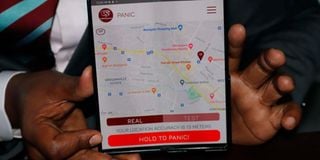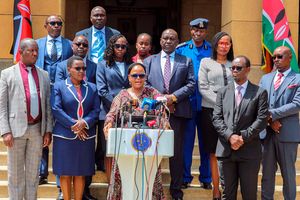Premium
Have a medical emergency? Here’s the button to press

What you need to know:
- The service has now been rolled out in 33 other towns where stable internet connectivity is available, to give peri-urban dwellers a taste of Kenya’s innovation in addressing societal challenges.
- These are Ukunda, Msambweni, Voi, Malindi, Watamu, Kajiado, Machakos, Limuru, Juja, Ruiru, Thika, Embu, Meru, Nanyuki, Nyeri, Nyahururu, Naivasha, Gilgil, Molo, Kericho, Kisii, Homa Bay, Migori, Awasi, Siaya, Busia, Bungoma Webuye, Kakamega, Kitale and Eldoret.
When Angeline Sua’s daughter started to shiver uncontrollably at 12am, she did not know what to do. She was perturbed and disconcerted.
Her one-year-old daughter had high temperatures, and the thought of taking her to hospital at night scared her.
She began calling friends and family frantically. However, after a few minutes, the tension was off her mind when a friend recommended an emergency response solution. “It was the Swift Response app that I downloaded in seconds and signed up,” the Kikuyu town resident tells Healthy Nation.
She narrates that after pressing the ‘panic’ button on the app, an emergency ambulance from AAR Health called her and was outside her house within two minutes.
“It was prompt and helpful. I took my daughter to hospital and she was treated immediately,” Angeline recalls. The app, just like taxi-hailing platforms such as Uber, uses machine learning algorithms and real-time geo-location data to determine which ambulance to dispatch for emergency services.
“We have 100 emergency providers with ambulances in our platform who respond to health cases that need immediate medical attention,” explains Samuel Karonji, founder and chief executive of Compland, which runs the service.
Having identified a gap in medical emergencies years ago, Mr Karonji began mooting the idea of connecting patients with emergency providers and hospitals.
But achieving his dream would further be catalysed by the living conditions brought about by the Covid-19 pandemic in 2020, where travel outside curfew hours was restricted.
He would later launch the service in August 2021 having learnt from several pilot studies across Nairobi estates on how best to address the problem. “Think of the passenger who gets badly injured after being knocked down by a vehicle or the epileptic family member who gets a sudden seizure. How can people respond for immediate treatment?” he poses.
When Healthy Nation logged on to the platform, we interacted with the interface of a much needed solution that could end the long queues in emergency rooms witnessed in most of Kenya’s health facilities. If for instance, a cardiac arrest patient collapses, a family member with the app logs in and touches a red panic button. A call from a nearby ambulance comes within one minute to ask about the condition.
When we pressed the button, a doctor called to confirm that he was on his way to Nation Centre, and arrived within five minutes, despite a traffic jam along Kenyatta Avenue, Nairobi. The fastest hospital ambulances usually arrive after 40 minutes.
If a patient fails to pick the phone twice, the paramedics understand it is a critical case, and only need to check the patient’s geo-location and come straight away.
To ensure medical responders are in constant standby, Mr Karonji says he began by issuing the ambulance operators on the Swift Response platform with smartphones and mobile internet data.
“I want to maintain 100 per cent internet uptime of the devices. So many lives depend on this app for survival,” he says.
According to data on the platform, cases that needed emergent care over the past six months include child birth, heart attacks, strokes, fractures, burns, deep cuts and bleeding, electric shocks, seizures, breathing difficulties and severe body pain.
Emergency responders on the service include AAR Health, St John’s Ambulance, Bressel Ambulance, Alpha Medica, Bellevue South Hospital, Critical Care Ambulance, EMR, Eagle Nursing Home, First Responders Medical Centre, Ivory Health Ambulances and Jamii Wellness Hospital.
Others are Ladnan, Life Med Ambulance, Morning Star, Nairobi East Hospital, Nairobi Women Hospital Sacco, OCOA Ambulances, Radmed, Radiant Hospital, Swift Paramedics, Virion Health, White Sparrow, Nakuru Nursing Home and Maternity Hospital and Quality Modern Ambulance.
So far, Mr Karonji discloses the platform has served 580 users, who are all rushed to hospital from inaccessible areas of the Nairobi Metropolitan zone, Mombasa, Kisumu and Nakuru and in conditions that required urgent medical attention.
The service has now been rolled out in 33 other towns where stable internet connectivity is available, to give peri-urban dwellers a taste of Kenya’s innovation in addressing societal challenges.
These are Ukunda, Msambweni, Voi, Malindi, Watamu, Kajiado, Machakos, Limuru, Juja, Ruiru, Thika, Embu, Meru, Nanyuki, Nyeri, Nyahururu, Naivasha, Gilgil, Molo, Kericho, Kisii, Homa Bay, Migori, Awasi, Siaya, Busia, Bungoma Webuye, Kakamega, Kitale and Eldoret.
“I came to know about it from a friend. Am in the transport business so all my drivers have installed the app. Any time passengers need emergency assistance my drivers use the app. This is boosting safety,” says Sylvester Kamau, a 32-year-old investor.
Users pay a monthly subscription of Sh2,000. But to cater for low income families which cannot afford the amount, Compland is betting on the Nyumba Kumi initiative to afford 20 families a single subscription. “In this case, every family pays only Sh100 per month,” says Mr Karonji.
A 2020 report by the Emergency Medicine Kenya Foundation shows that Kenya lacks an integrated public ambulance system, with most patients being taken to hospital by private means, taxis or boda bodas.
A majority of the existing ambulances, notes the survey, are private and despite the existence of the Ambulance Standards developed by the Kenya Bureau of Standards in 2013 and revised in 2019, very few ambulances meet these standards.
“The emergency medical treatment fund should be established immediately as stipulated in the Health Act 2017,” states the report.
It recommends that the emergency services benefit package proposed under the Universal Health Coverage be rolled out across the entire healthcare system.





